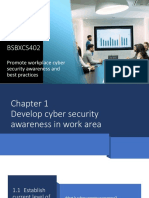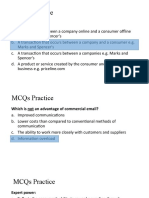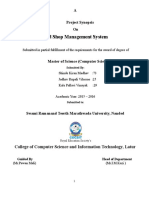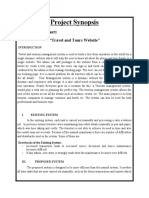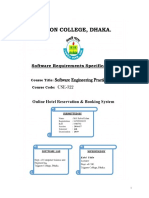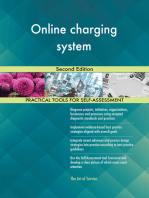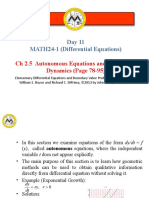0 ratings0% found this document useful (0 votes)
2K viewsSRS - Travel Agency
SRS - Travel Agency
Uploaded by
007mailThis document outlines the software requirements for a travel agent file transfer software called "The Journey Project". It will allow travel agents to download electronic brochures and files from remote servers operated by tour companies, replacing paper files. The software will have a graphical user interface for browsing directories and transferring files between local and remote computers using FTP, Telnet, or Windows file sharing protocols. It will also provide online help and documentation for installation and use.
Copyright:
Attribution Non-Commercial (BY-NC)
Available Formats
Download as PDF, TXT or read online from Scribd
SRS - Travel Agency
SRS - Travel Agency
Uploaded by
007mail0 ratings0% found this document useful (0 votes)
2K views11 pagesThis document outlines the software requirements for a travel agent file transfer software called "The Journey Project". It will allow travel agents to download electronic brochures and files from remote servers operated by tour companies, replacing paper files. The software will have a graphical user interface for browsing directories and transferring files between local and remote computers using FTP, Telnet, or Windows file sharing protocols. It will also provide online help and documentation for installation and use.
Original Title
SRS- Travel Agency
Copyright
© Attribution Non-Commercial (BY-NC)
Available Formats
PDF, TXT or read online from Scribd
Share this document
Did you find this document useful?
Is this content inappropriate?
This document outlines the software requirements for a travel agent file transfer software called "The Journey Project". It will allow travel agents to download electronic brochures and files from remote servers operated by tour companies, replacing paper files. The software will have a graphical user interface for browsing directories and transferring files between local and remote computers using FTP, Telnet, or Windows file sharing protocols. It will also provide online help and documentation for installation and use.
Copyright:
Attribution Non-Commercial (BY-NC)
Available Formats
Download as PDF, TXT or read online from Scribd
Download as pdf or txt
0 ratings0% found this document useful (0 votes)
2K views11 pagesSRS - Travel Agency
SRS - Travel Agency
Uploaded by
007mailThis document outlines the software requirements for a travel agent file transfer software called "The Journey Project". It will allow travel agents to download electronic brochures and files from remote servers operated by tour companies, replacing paper files. The software will have a graphical user interface for browsing directories and transferring files between local and remote computers using FTP, Telnet, or Windows file sharing protocols. It will also provide online help and documentation for installation and use.
Copyright:
Attribution Non-Commercial (BY-NC)
Available Formats
Download as PDF, TXT or read online from Scribd
Download as pdf or txt
You are on page 1of 11
Software Requirements Specification
Travel Agent File Transfer Software
"The Journey project
Mark Cunningham
James Dyer
Zhili He
Cory McKay
Maru Newby
Jonathan O'Hara
Tristram Southey
Sitai Sun
David Tarc
Xinli Wang
TABLE OF CONTENTS
I. INTRODUCTION......................3
1.1 Purpose oI this Document................3
1.2 Scope...........................3
II. GENERAL DESCRIPTION................4
2.1 Product Description....................4
2.1.1 Overview........................4
2.1.2 TransIer Capabilities..................4
2.1.3 On-line Help.....................4
2.1.4 Setup Documentation...................4
2.2 User Characteristics......................4
2.3 Operating Environment................5
2.4 General Constraints...................5
2.4.1 Language.......................5
2.4.2 SoItware........................5
2.4.3 Operating Systems....................5
2.4.4 Communication Protocols..............5
III. SPECIFIC REQUIREMENTS..............6
3.1 Installation .....................6
3.2 Online Help....................6
3.3 InterIace.......................6
3.4 Login Procedure...................6
3.5 Protocol Determination.................6
3.6 Directory Navigation..................7
3.7 File TransIer...................7
IV. REQUIREMENTS VALIDATION............8
4.1 Client Validation.....................8
4.2 Testing.........................8
4.3 Prototyping.....................8
V. CONCLUSION....................9
VI. GLOSSARY.....................10
I. INTRODUCTION
1.1 Purpose of this Document
This document is provided in order to ensure that the soItware we produce will be
consistent with the needs oI our client. It is a description oI the project requirements
that we have been provided with. Stating these requirements explicitly helps insure
that any potential miscommunications are dealt with at an early stage, when the cost
oI implementing changes is still low.
This document is divided into several sections. The Iollowing section will present a
general description oI the product that we are working on. The Iocus will then be
narrowed in the next section to deal with speciIic requirements. There will then be a
section explaining the processes that we will employ to ensure the quality oI our
product. Finally, there will be a brieI summary oI the project.
We encourage our client to distribute this document among their travel agents and
management in order to provide us with Ieedback. This will help us ensure that our
end product Iully meets their needs. This document will also be a useIul resource Ior
those who will be upgrading or maintaining the soItware aIter it has been completed.
1.2 Scope
A piece oI soItware entitled 'Journey will be our ultimate product. This soItware
will Iacilitate the work oI travel agents by allowing them to connect to remote servers
and transIer computer Iiles to or Irom their own computers. These complex processes
will be easily accomplished by means oI an intuitiv point-and-click interIace. It
will also allow the travel agents to set their computers to automatically transIer many
large computer Iiles overnight so that they will be available Ior perusal in the
morning.
II. GENERAL DESCRIPTION
2.1 Product Description
2.1.1 Overview
This soItware will allow travel agents to eliminate the paper inIormation brochures
that they receive Irom tour companies by downloading electronic versions oI these
brochures directly Irom the computers oI the tour companies. This will reduce paper
costs and will also increase the accessibility oI inIormation that is stored at distant
locations.
2.1.2 Transfer Capabilities
The travel agents will use our soItware to connect to pre-existing remote servers
containing the required inIormation Iiles. The agents will then make use oI a simple
graphical user interface (GUI) to see what Iiles are available on these remote servers,
download the ones that they desire or upload additional Iiles. II they wish, they will
also be able to create a list oI Iiles that they would like to transIer automatically. This
will enable them to transIer Iiles to and Irom their computers overnight, in case the
transfer rate is slow or the Iiles that they wish to download are very large.
2.1.3 On-line Help
An on-line help system will be provided along with the soItware in order to serve as a
reIerence and to help new users learn to use the program.
2.1.4 Setup Documentation
Documentation will be provided on how to install our soItware and how to access the
more complete reIerence inIormation available on the on-line help system.
2.2 User Characteristics
The travel agents who will be using our product will have a basic Iamiliarity with
personal computers and a working knowledge oI systems with graphical user
interfaces. The travel agents are not assumed to have any understanding oI
networking or Iile transIer methods. The only speciIic inIormation the travel agents
are required to have is the name oI the server they wish to connect to, a login name,
and a password iI the remote servers security conIiguration demands it.
2.3 Operating Environment
The system is designed to run under X-Windows and Windows 9x/NT based
computers. There must be a Iunctional network linking the travel agents` computers
and the tour company` servers. The travel agents` computers will be upgraded by the
client to ensure that they will be capable oI running our soItware. Considerations in
this matter include a minimum resolution oI 800x600 pixels and the ability to run
Java v1.2 programs. The remote servers that the Iiles will be downloaded Irom or
uploaded to will be using any oI the above operating svstems, but will be assumed to
be running the appropriate server software (which will be supplied by the client).
2.4 General Constraints
2.4.1 Language
The soItware will only operate in English.
2.4.2 Software
The soItware will be written and run using JDK 1.2.
2.4.3 Operating System
The soItware will be used on X-Windows or Windows 9x/NT based computers.
2.4.4 Communication Protocols
The remote servers Irom which Iiles will be downloaded must be able to use at least
one oI the Iollowing communication protocols: File Transfer Protocol, Telnet or
Windows File Sharing.
III. SPECIFIC REQUIREMENTS
3.1 Installation
3.1.1 Instructions on how to install the system shall be provided.
3.1.2 The system shall be provided with an installation mechanism.
3.2 Online Help
3.2.1 The system will have an online help Iacility.
3.3 Interface
3.3.1 The system will have an easy to use graphical user interface (GUI) to the user.
3.3.2 The GUI will provide Ieedback to the users.
3.3.3 The GUI will allow directory navigation on the travel agents` computers.
3.3.4 The GUI will allow directory navigation on the remote servers.
3.3.5 The GUI will allow Iile transIers.
3.4 Login Procedure
3.4.1 The system shall require users to enter the host name or address oI the remote
server they wish to connect to.
3.4.2 The system shall display an appropriate error message when unable to connect
to a remote server.
3.4.1 The system shall require users to enter their usernames and passwords that they
wish to use connecting when connecting to remote servers.
3.4.2 The password shall not be displayed on-screen when a user types it in.
3.4.3 The system shall display an appropriate error when a username or password are
Iound to be incorrect by a remote server.
3.4.4 A list oI the most recently accessed remote servers and the usernames used to
access those servers will be available to users.
3.5 Protocol Determination
3.5.1 The system shall be capable oI connecting to remote servers using any oI the
Iollowing protocols:
- File Transfer Protocol
- Telnet
- Windows File Sharing
3.5.2 The deIault will be to automatically determine which protocol to use when
communicating with a remote server.
3.5.3 The system shall permit users to choose a speciIic protocol to use in connecting
to a remote server iI they wish.
3.5.4 The system shall display an appropriate error when a remote server cannot
transIer Iiles via supported protocols.
3.6 Directory Navigation
3.6.1 The system will display a list oI Iiles and directories in the current directory oI
the local computer.
3.6.2 The system shall display a list oI Iiles and directories in the current directory oI
any remote server that it is connected to.
3.6.3 The system shall display the Iollowing properties oI each Iile and directory:
name, date modiIied and size.
3.6.4 The system shall allow the user to sort the contents oI a directory by name,
date modiIied or size.
3.6.5 The system shall allow users to change the current directory.
3.6.6 The system shall allow users to select the deIault local current directory.
3.6.7 The system shall display an error iI a user is not permitted access to local or
remote Iiles or directories.
3.7 File Transfer
3.7.1 The system shall permit users to select one or more Iiles or directories Irom the
current directories oI the remote server or the local computer to be transIerred.
3.7.2 The system shall allow users to choose to transIer selected items immediately or
at a later time.
3.7.3 The system will display the items selected Ior transIer in a list ordered by
priority.
3.7.4 The system will allow users to modiIy the list oI items to transIer by removing
them, adding them and reordering the list.
3.7.5 The system shall display the progress oI the current transIer.
3.7.6 The system shall permit users to pause and resume transIers while they are in
progress.
3.7.7 The system will transIer items Irom the local computer into the current Iolder on
the remote server.
3.7.8 The system will transIer items Irom the remote server into the current Iolder on
the local computer.
3.7.9 The system shall keep a log oI items transIerred.
3.7.10 The system shall display an error iI unable to transIer an item.
3.7.11 The system shall attempt to continue processing pending transIers when an
error occurs.
IV. REQUIREMENTS VALIDATION
4.1 Client Validation
We ask the client to review this requirements document and present it to its travel
agents. This will ensure that our conception oI the product is consistent with what is
desired. We will appreciate any and all requests Ior additions or changes at this stage,
as these will be much more costly to implement at later stages oI the production
process.
4.2 Testing
We will continually test our product at all stages oI production in order to ensure that
it is Iully Iunctional. This will include connecting to the remote servers and
attempting to perIorm all oI the operations that our program is required to perIorm.
This will include transIerring many diIIerent types oI Iiles to and Irom local
computers and remote servers. Tests will also be perIormed to ensure that our
program Iunctions well when problems occur such as external interruptions in
network connections, attempting to transIer Iiles Ior which we do not have access and
attempting to log in using incorrect login inIormation. We will test that Iiles can be
transIerred using all oI the supported communications protocols. We will also ensure
that our product Iunctions under all oI the supported operating svstems. Essentially,
we will attempt to do all oI the things with our program that users will be able to do
and we will make sure that it continues to Iunction properly iI it is used improperly or
iI external problems occur.
4.3 Prototyping
We will present the client with working prototypes oI limited Iunctionality at various
stages oI the production process. This will enable the client to be Iully aware oI our
progress and provide useIul Ieedback.
VI. CONCLUSION
It is our hope that this document will be the Iirst part oI a continuing series oI
interchanges between ourselves and our client. This will ensure that the needs oI the
client are met in a cheap and timely way. It will be important to involve the travel agents
in this Ieedback process, as end-users such as they oIten have many unique insights that
might not occur to soItware developers or people involved in management. This
interchange will involve both inIormation such as this document and prototypes oI our
product. The end result will be a product that is Iunctional, reliable and easy to learn and
use.
V. GLOSSARY
Compile transIorming inIormation written in a language used by computer
programmers to write soItware into inIormation that is directly understandable to a
computer.
Default Folder a Iolder that a computer program automatically assumes will be the
destination or source Ior Iiles.
FTP File TransIer Protocol. A standard way to transIer Iiles between computers.
Graphical User Interface an interIace between the user and a piece oI soItware that
allows him or her to interact with the program using a mouse, windows, dialogue boxes,
menus, buttons, etc.
1ava Code a language that programmers use to write soItware.
Linux an operating svstem that is an alternative to MicrosoIt Windows.
Log File a Iile that contains a list oI actions perIormed by a computer.
Maintaining Software the process oI perIorming maintenance work on soItware in
order to Iix any problems that might arise.
Networking connecting two or more computers together so that they can share
inIormation.
On-Line Help System a reIerence on how to use our product that will be made
available by choosing an item Irom a menu in our soItware.
Operating System the soItware that allows computer programs to interact with each
other and with the hardware oI a computer. Examples include Linux (Red Hat, Debian,
Corel etc), Unix, MicrosoIt Windows 95, MicrosoIt Windows 98, MicrosoIt Windows
NT and many many others.
Remote Servers computers at arbitrary locations that the users oI our product will be
able to connect to using telecommunications. These computers will hold the Iiles that the
travel agents will want to download.
Running the process oI using a particular piece oI soItware.
Server Software the soItware that enables computers to work as remote servers.
Telnet accessing another computer by means oI setting your computer to behave as iI it
were the other computer.
Transfer to pass electronic data Irom one computer to another, either uploading
(sending) or downloading (receiving) the data, usually utilizing networking technology.
Transfer Rate the speed at which inIormation is transIerred Irom a remote server to a
user`s computer. This speed is determined by the telecommunications inIrastructure
involved as well as the hardware installed on the user`s computer and at the remote
server.
Upgrading Software the process oI creating a new version oI a piece oI soItware with
increased Iunctionality and/or improved perIormance.
Windows File Sharing a means oI transIerring Iiles that comes standard with
MicrosoIt Windows.
X-Windows an application Ior Unix and Linux which greatly aids in the creation and
standardization oI graphical user interfaces.
You might also like
- Review Answers: Your AnswerDocument3 pagesReview Answers: Your Answerpink burger50% (2)
- Supply Chain Management For Dummies - A Quick RefresherDocument2 pagesSupply Chain Management For Dummies - A Quick Refresherrenzoc.helixNo ratings yet
- IIT Bhubaneswar School of Electrical Sciences: Lab Schedule: Tue (2:30 Instructor: Teaching AssistantDocument3 pagesIIT Bhubaneswar School of Electrical Sciences: Lab Schedule: Tue (2:30 Instructor: Teaching AssistantNitishkumarreddyervaNo ratings yet
- BSBXCS402 PresentationDocument27 pagesBSBXCS402 PresentationAlejandro Bejarano GarciaNo ratings yet
- Cw2 Mock Mcqs & AsDocument20 pagesCw2 Mock Mcqs & AsDeep DesaiNo ratings yet
- Technical ProposalDocument7 pagesTechnical ProposalMD ABUL KHAYERNo ratings yet
- Profs MCQ!Document22 pagesProfs MCQ!kaksdvoNo ratings yet
- System Design SpecificationDocument8 pagesSystem Design Specificationapi-278499472No ratings yet
- Gold Shop ManagementDocument11 pagesGold Shop ManagementSantosh BirajdarNo ratings yet
- Hostel Finder SynopsisDocument4 pagesHostel Finder Synopsisanon_359930518100% (1)
- Travel Management SystemDocument67 pagesTravel Management SystemSuvayan Ghosh67% (6)
- Support Systems Admin CV and Resume SampleDocument2 pagesSupport Systems Admin CV and Resume SampleMike Kelley100% (2)
- Client Server Architecture A Complete Guide - 2020 EditionFrom EverandClient Server Architecture A Complete Guide - 2020 EditionNo ratings yet
- Offshore StructuresDocument24 pagesOffshore StructuresSaaiyogeshNo ratings yet
- Tour and Travel Final Project ReportDocument88 pagesTour and Travel Final Project ReportAnsari Zaid100% (1)
- SRS Tourism Management SystemDocument9 pagesSRS Tourism Management SystemAakriti Goyal100% (1)
- Online Travel and TourismDocument40 pagesOnline Travel and TourismAbhijith SNo ratings yet
- Library Management SystemDocument17 pagesLibrary Management Systemvishal kumarNo ratings yet
- Tour & Travel Management SystemDocument8 pagesTour & Travel Management SystemChandrani GhoshNo ratings yet
- Travel and Tour Management System SynopsisDocument4 pagesTravel and Tour Management System SynopsisKeeriiNo ratings yet
- Hotel Management DFDDocument7 pagesHotel Management DFDMehadi Hasan RoxyNo ratings yet
- Tourism Management System SynopsisDocument10 pagesTourism Management System SynopsisabcNo ratings yet
- Online Crime ReporterDocument28 pagesOnline Crime ReporterSB khanNo ratings yet
- Tourism Management SystemdocxDocument93 pagesTourism Management SystemdocxXtylish UmerNo ratings yet
- T003a TMU Project Report Template v1.3Document21 pagesT003a TMU Project Report Template v1.3aditya JainNo ratings yet
- Android Projects On Food Waste Management: AbstractDocument29 pagesAndroid Projects On Food Waste Management: AbstractakhilNo ratings yet
- Srs - Document - For - Hotel - Management - System Md. Rabiul IslamDocument27 pagesSrs - Document - For - Hotel - Management - System Md. Rabiul IslamRobiul IslamNo ratings yet
- Test Plan - Real EstateDocument5 pagesTest Plan - Real Estatedevid mandefroNo ratings yet
- Telephone Billing SystemDocument30 pagesTelephone Billing Systemmohit29% (7)
- Travel Bill Tracking SystemDocument10 pagesTravel Bill Tracking SystemVKM20130% (1)
- SRS Property SaleDocument37 pagesSRS Property SaleM.Basit RahimNo ratings yet
- Project Report Final - Find My TutorDocument63 pagesProject Report Final - Find My TutorAbhishekNo ratings yet
- Project ReportDocument6 pagesProject ReportIruei Maker sniperNo ratings yet
- SRS - Online Car Rental System 1Document6 pagesSRS - Online Car Rental System 1Prem Sai Reddy PittaNo ratings yet
- Travel Agency C++ Project ReportDocument21 pagesTravel Agency C++ Project ReportvarshaNo ratings yet
- Online Job Portal SystemDocument20 pagesOnline Job Portal SystemHijas Ahmed67% (3)
- GPS Based Attendance SystemDocument7 pagesGPS Based Attendance SystemBashir IdrisNo ratings yet
- Hotel Management SystemDocument34 pagesHotel Management SystemAnari Anthony100% (1)
- Hotel Management System Database DesignDocument25 pagesHotel Management System Database DesignRosna KhanalNo ratings yet
- Software Requirement SpecificationDocument3 pagesSoftware Requirement SpecificationBharat BugaliaNo ratings yet
- Online Car TradingDocument6 pagesOnline Car TradingVijayAVjNo ratings yet
- Srs Document For Hotel Management SystemDocument20 pagesSrs Document For Hotel Management SystemYASH GAIKWADNo ratings yet
- Index: 1. Problem StatementDocument6 pagesIndex: 1. Problem StatementDhanlaxmiNo ratings yet
- Bankbazaar Cse320 ProjectDocument18 pagesBankbazaar Cse320 ProjectVarun GupthaNo ratings yet
- Hotel Management SystemDocument57 pagesHotel Management SystemAni Roy0% (2)
- Finoptiz Tour and Travel Management SystemDocument22 pagesFinoptiz Tour and Travel Management Systemkodali utej100% (2)
- Chapter One: Real Time Android Application (Text) Through Socket Using Bluetooth Technology Page 1Document56 pagesChapter One: Real Time Android Application (Text) Through Socket Using Bluetooth Technology Page 1student wwNo ratings yet
- Online Hotel Management System AbstractDocument2 pagesOnline Hotel Management System AbstractEngineers SolutionNo ratings yet
- 1.1 Purpose: PrefaceDocument6 pages1.1 Purpose: PrefaceseemabNo ratings yet
- Srs On Online Booking System PDFDocument9 pagesSrs On Online Booking System PDFZeeshan AbbasNo ratings yet
- Student Tracking and Attendance Monitoring System Using RFIDDocument5 pagesStudent Tracking and Attendance Monitoring System Using RFIDGaspar Howell MingaNo ratings yet
- Placement Automation SystemDocument57 pagesPlacement Automation SystemAsif Koujaganur100% (1)
- Advanced Intelligent Tourist GuideDocument3 pagesAdvanced Intelligent Tourist Guidevijayasarathi458No ratings yet
- Final SRSDocument11 pagesFinal SRSPadmavati Shaha100% (1)
- Job Portal SystemDocument4 pagesJob Portal SystemRameshwar KanadeNo ratings yet
- Updated Final Year Project FinalDocument40 pagesUpdated Final Year Project FinalSourav Poddar0% (1)
- Business Requirement Document-2019: Agent Portal ManualDocument21 pagesBusiness Requirement Document-2019: Agent Portal ManualSazwalNo ratings yet
- Restaurant Management SystemDocument30 pagesRestaurant Management SystemRN RoNnYNo ratings yet
- PBL - Sample SRSDocument11 pagesPBL - Sample SRSAnish YadavNo ratings yet
- Public Cloud ERP for Small or Midsize Businesses A Complete Guide - 2019 EditionFrom EverandPublic Cloud ERP for Small or Midsize Businesses A Complete Guide - 2019 EditionNo ratings yet
- Information Security Policy A Complete Guide - 2019 EditionFrom EverandInformation Security Policy A Complete Guide - 2019 EditionNo ratings yet
- Software Requirements Specification: Name - Suraj Singh Reg - No - 11801269 Roll - No - 12Document18 pagesSoftware Requirements Specification: Name - Suraj Singh Reg - No - 11801269 Roll - No - 12surajrani100% (1)
- Blood Relation Aptitude QuestionsDocument8 pagesBlood Relation Aptitude Questions007mailNo ratings yet
- NCTUNS Installation Guide: Posted by Admin On July 11th, 2010Document8 pagesNCTUNS Installation Guide: Posted by Admin On July 11th, 2010Amita MalikNo ratings yet
- Installation Tutorial of Fedora 11 Virtual Machine With NCTUNS 6Document2 pagesInstallation Tutorial of Fedora 11 Virtual Machine With NCTUNS 6007mailNo ratings yet
- Installation Tutorial of Fedora 11 Virtual Machine With NCTUNS 6Document2 pagesInstallation Tutorial of Fedora 11 Virtual Machine With NCTUNS 6007mailNo ratings yet
- Lexical Analysis: Leonidas FegarasDocument28 pagesLexical Analysis: Leonidas Fegaras007mailNo ratings yet
- Business Analyst ResumeDocument2 pagesBusiness Analyst Resume007mailNo ratings yet
- Kobra 400 Hs-OmDocument3 pagesKobra 400 Hs-OmShredman10No ratings yet
- Fluid Mechanics & Hydraulics Lab: (Minor Head Losses)Document9 pagesFluid Mechanics & Hydraulics Lab: (Minor Head Losses)Ali Ib TarshaNo ratings yet
- Serving Mining Industries and Civil Engineering Projects of India and Abroad, Since 2002Document48 pagesServing Mining Industries and Civil Engineering Projects of India and Abroad, Since 2002Amrik Singh PahwaNo ratings yet
- Finance PresentationDocument15 pagesFinance PresentationShahveer KhalidNo ratings yet
- 11.2.5 - Autonomous Equations and Population DynamicsDocument29 pages11.2.5 - Autonomous Equations and Population DynamicsEkoms GamingNo ratings yet
- Manual JRIBBON JAVADocument130 pagesManual JRIBBON JAVAJavier Augusto ReyesNo ratings yet
- BOOK TWO Crimes Against Public Order Until Art. 150Document19 pagesBOOK TWO Crimes Against Public Order Until Art. 150jake31No ratings yet
- Control Panel: Xerox Workcentre 5945 / 5955Document14 pagesControl Panel: Xerox Workcentre 5945 / 5955Ganiza LongNo ratings yet
- Pharmacognosy Lecture 9+10 (Oils + Waxes) (By, Sir Tanveer Khan)Document17 pagesPharmacognosy Lecture 9+10 (Oils + Waxes) (By, Sir Tanveer Khan)Arslan Abdullah100% (1)
- Zaiger Motion To ContinueDocument2 pagesZaiger Motion To ContinueSusanBaskoNo ratings yet
- Media Cloud: An Open Cloud Computing Middleware For Content ManagementDocument6 pagesMedia Cloud: An Open Cloud Computing Middleware For Content Managementmr_harisskumarNo ratings yet
- An61546 001-61546Document9 pagesAn61546 001-61546Aldrin Pascual Clavijo MéndezNo ratings yet
- PM - SDD - Master Data - V1.0Document13 pagesPM - SDD - Master Data - V1.0Dhanush S T100% (1)
- SEAHORSE TAB by Devendra Banhart @Document3 pagesSEAHORSE TAB by Devendra Banhart @H. Julián Becerra VilladaNo ratings yet
- وصف البرنامج الاكاديمي قسم الالكترونيك والاتصالات 1Document111 pagesوصف البرنامج الاكاديمي قسم الالكترونيك والاتصالات 1العراقيNo ratings yet
- The Big Picture The Faulty Economic Model Behind America's Support For Dictators (Instead of Democracies) PrintDocument5 pagesThe Big Picture The Faulty Economic Model Behind America's Support For Dictators (Instead of Democracies) PrintltfreedNo ratings yet
- Delonghi AD1079B Retro Convection OvenDocument21 pagesDelonghi AD1079B Retro Convection Ovendoc57820No ratings yet
- Shopping For Clothes: Conversation Cheat SheetDocument2 pagesShopping For Clothes: Conversation Cheat SheetAugustas IvanauskasNo ratings yet
- Grinding Damage Prediction For Ceramics Via CDM Model: Bi ZhangDocument8 pagesGrinding Damage Prediction For Ceramics Via CDM Model: Bi ZhangDakhlaouiNo ratings yet
- Enterprise Design GuideDocument214 pagesEnterprise Design Guidec_simosNo ratings yet
- TCP-IP Unleashed, Third EditionDocument1,117 pagesTCP-IP Unleashed, Third Editiongopi_merugu100% (4)
- Institute Name: Indian Institute of Technology Hyderabad (IR-O-U-0013)Document14 pagesInstitute Name: Indian Institute of Technology Hyderabad (IR-O-U-0013)Zain RashidNo ratings yet
- Chapter 1 & Chapter 2 Sosiologi Tahap IDocument11 pagesChapter 1 & Chapter 2 Sosiologi Tahap ICitraNo ratings yet
- Final Report For Digital MarketingDocument51 pagesFinal Report For Digital MarketingUnknown Star100% (1)
- Application of Information and Technology in Supply Chain Management of Fruits and Vegetables - A Brief OverviewDocument7 pagesApplication of Information and Technology in Supply Chain Management of Fruits and Vegetables - A Brief OverviewInternational Journal of Innovative Science and Research TechnologyNo ratings yet



